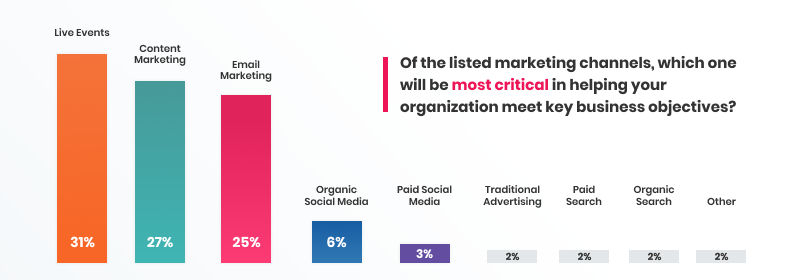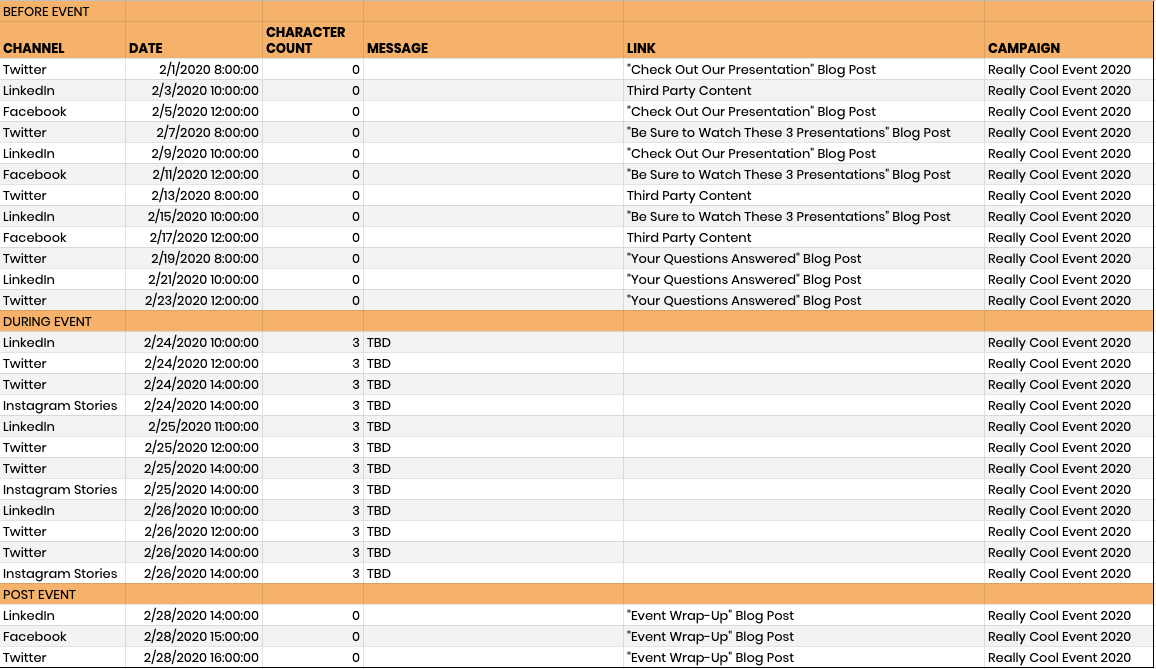“Why should I develop an event marketing strategy?”
Live events are rapidly becoming one of the most popular ways to market brands, and for good reason. If your business has never participated in a live event, it’s time to consider a change. Not only are they an excellent opportunity to promote your brand among other companies in your industry, but they also help develop personal, one-on-one connections between your business and its customers.
These relationships can be priceless—in a 2018 survey, 31% of marketers argued that live events are the single most valuable marketing channel a business can leverage. In fact, the average CMO devotes a whopping 24% of their annual budget to live event promotion and participation, valuing events more than digital advertising and content marketing.

Data from Bizzabo
But, let’s not get ahead of ourselves. Live events are indeed very valuable, but only when brands put in the preparation necessary beforehand. Creating an effective event marketing strategy is the difference between increasing your brand’s return on investment and completely wasting your time at a tradeshow, conference, or other industry event.
To help you get the most out of your next live event, we’ve put together this tried-and-true promotion plan and timeline to guide you through the before, during, and post-event stages.
Table of Contents
- Pre-event content
- Pre-event social media plan
- Social media best practices
- Pre-event email plan
- Staying engaged during the event
- Post-even plan
- Next steps
Pre-event content
Content marketing is a key piece of any live event promotion plan—before the event even begins, you can provide your audience with valuable information. But what should you write about during the lead-up period? There are a few places you should go to get content ideas:
- Your Own Presentation – Write some teaser content about your brand’s involvement in the event. Without spoiling the presentation content, highlight the importance and impact the talk will have on attendees and urge them to register. This is a great blog post to share about a month before the event so that users have plenty of time to buy tickets, if they haven’t already.
- Event Website – This is a goldmine of content ideas. Not only can you write about the event goals, but you can also highlight other presentations that align with your brand and its mission. Share your completed blog post with whoever is featured in it and ask them (politely) to share on their social channels. Plan to publish this post about three to two weeks before the event start date.
- Social Media – This is where your social media listening skills come into play—find out what questions people are asking about the conference and/or specific topics and use those as a prompt for a helpful blog post. For example, you might end up writing something similar to this post from IMPACT titled “Are you prepared for INBOUND 2017? Here’s what to expect.” It answers everything from networking best practices all the way down to packing tips. Share this post about a week away from the event start date.
You’ll want to start content planning and writing well in advance so there’s plenty of time to promote these posts via social media and email, which we will dive into in the next sections.
Pre-event social media plan
There are quite a few moving parts when it comes to event marketing on social media, so it’s important to stay organized and use a social media calendar. If you’ve never used one before, this is a great time to create one—check out this awesome guide from HubSpot that’s chockablock full of templates and advice to get you started. At Raka, we use the calendar below for live event social media:

We’ve spaced out publishing three pre-event blog posts, as well as a few pieces of relevant content from third-party sources. We recommend sourcing third-party content from other presenters or brands that will be at the event. You’ll easily find content surrounding live events if you do a little hashtag research. First, start following the official event hashtag wherever possible (networks like Twitter, Instagram, and Facebook allow users to follow and track hashtags). Then, check out what other hashtags users are adding to their event-related posts. This is an excellent way to extend your social media reach without putting in an exhausting amount of effort.
Need a few pointers on social media best practices? We’ve got you covered
It’s easy to get wrapped up in a moment and hit that “share” button before a post is ready to be sent into the ether, and this can lead to low-quality social posts (best-case scenario) or even get you in trouble with higher-ups on your team (worst-case scenario). We’re here to help you avoid that. Use these basic, easy-to-remember best practices in order to post to social media with confidence.
- Hashtags – Use event and event-related hashtags on LinkedIn, Twitter, and Instagram posts. While using hashtags is an option on Facebook, we recommend avoiding it—studies have shown that hashtags can actually hurt post performance on their platform.
- Images – Each post should be accompanied by an image, unless of course you are live-tweeting a presentation rapidly. Posts with images tend to receive more engagement than regular text posts.
- Image Quality – Share high-quality, carefully curated images. Remember that your brand’s social media represents your entire business, so take care to share images that are cropped correctly, aren’t blurry, and fit well with the platform you’re sharing them on. For example, you might not want to share a picture of your team at an event cocktail hour on LinkedIn, but it may be appropriate to share it on Instagram.
- Videos – Take and share videos! Video tends to perform better on nearly every social media channel, so don’t be afraid to leverage it on your own. But, as we mentioned before, be sure to only share the best-quality videos possible. You don’t need fancy equipment (an iPhone is fine), but make sure to shoot your videos horizontally!
- Permission – Get permission before you share a photo or video featuring other people prominently. A simple “Hey, is it alright if I post this picture to our company’s Twitter?” should suffice! It’s important to respect people’s privacy, should they not want their picture on social media.
Pre-event email plan
Email marketing completes the trifecta of live event marketing. Use email to reach out to your subscribers who’ve opted in to receive information about news and events from your company. We recommend planning three emails to send out before the event begins, sent in conjunction with the three blog posts you write.
There are a few email marketing best practices to keep in mind as you plan, write, and set up these emails:
- Do keep your subject line and header specific, so they clearly spell out what content users will find inside. Don’t use click-baity subject lines like “Your FREE Guide to This Cool Event!” because chances are, it will get flagged as spam and won’t make it into anyone’s inbox.
- Do add personalization to emails whenever possible. HubSpot’s CRM makes it simple to add recipients’ first names to emails automatically, so you can send out personalized emails without spending all day typing them out. Don’t make the email sound like a mass email you’ve sent out to a thousand contacts (even if it is).
- Do include descriptive CTAs in your email which will tell users exactly what will happen if they click on a button—”Read the Guide” is a great CTA. Don’t use vague CTAs like “Learn More” because they don’t really say anything.
Remember your goal is to provide value to your audience and promote awareness about the event. Hence, your emails need to be short, sweet, and engaging for them to be effective.
During the event: staying engaged
Your brand needs to put a plan in place ahead of time that will help you stay active on social media during the course of the event. Do you have members from your team attending the event? Great! Put one or two of them in charge of live tweeting, taking pictures, and reposting content from other event attendees.
Be sure that your team members are ready to go before they even hit the event floor—they’ll need access to your brand’s social media accounts, know which hashtags to use in posts, how and when to tag other users in posts, and understand your social media policy. If it helps, you can also set a rough plan for how many times a team member should post to each social media channel over the course of the event. This way, you can rest assured that your brand won’t go radio-silent during the event and you will still be posting high-quality, relevant content.
Post-event plan
Just because the event is over doesn’t mean you suddenly get to stop marketing it! After the event is an excellent opportunity to leverage all the new and exciting knowledge and tidbits of wisdom you acquired at the event.
Your first step is to write a blog post. Not just any generic recap blog post, either. Ask yourself what your audience might want to learn more about after the event—were users asking questions about your presentation on social media? Can you go into more depth about a specific topic that there wasn’t time for during the presentation? Remember that many of the users who will visit this blog post are people who didn’t even attend the event; they’re simply interested in the speaker’s expertise on a topic. Focus on creating a valuable, evergreen blog post that can live on your website for years to come.
You’ll also want to promote this blog post via social media and email. Draft up some social posts that thank the event attendees for coming and include a small teaser excerpt from your blog post. Your emails should also thank anyone who attended, as well as provide a clear path for the next steps you want users to take (e.g. “Read our latest blog post, where we break down the importance of post-event marketing and how it can help you drive more web traffic and leads”). Taking the time to market your brand after an event can extend your return on investment.
Next steps
How did your event go? Can you see analytical data on your social posts, emails, and blog posts? How did your event-related marketing efforts measure up to expectations? What do you need to change going forward for future events? This is your chance to reflect on your event marketing effectiveness and make note of successes and lessons learned. Use this opportunity to strategize ways to optimize your return on investment at an upcoming event, and remember that marketing is constantly evolving. Make sure your company is making the shifts and adjustments it needs to keep up.
If you have more questions about event marketing strategy, or need assistance, Raka’s marketing experts would be happy to help.






